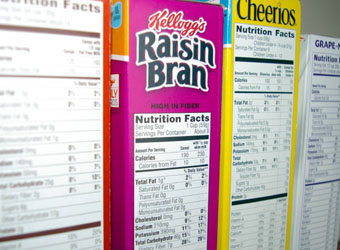
Better Food Labels on the Way?
By R. Alan Clanton | published Saturday, January 25, 2014 |
Thursday Review editor
Are you one of those conscientious people who take the time to look at the fat content or the sugar content of products you buy at the store? You may be in the minority of food consumers who bother to read those labels, but the U.S. Food and Drug Administration, pending White House approval, is going to make your life easier—very soon.
The USDA—like many consumer and food safety organizations—has concluded that the current food labelling system, so familiar on packages and containers found in grocery stores, is outdated and does not accurately reflect current medical science. Advances in dietary science and decades of new research have left those labelling systems behind. Furthermore, new knowledge about sugar, fat and carb content had made many products’ labels irrelevant or misleading.
Americans have become far more health conscious, and the USDA says its own studies indicate that more people do take the time to read those labels, meaning that the information is not merely a waste of space on packages. According to the USDA website, the use of the nutrition information panel has increased greatly in recent years, with "forty-two percent of working age adults and 57 percent of older adults...using the Nutrition Facts Panel most of all of the time when making food choices."
But, even as consumers have become knowledgeable about their diet and health over the last 20 years or more, the packaging leaves many confused—especially when food values are measured in grams, a metric unit unfamiliar to the majority of Americans. And in many instances the percentage content is also confusing in the context of newer science.
In addition, some activist and consumer groups want better explanations of sugar and salt content—long a sore point with health advocates who argue that many packaged foods contain hidden sources of sugar and sodium. Many consumer advocate groups want to see improved is accurate information about the variety of sugar, corn syrup, corn starch, caramel, cane sugar and brown sugar added (or occurring naturally) in many products—but simply different ways to say “sugar.”
An example would be Post “Honey Bunches of Oats” breakfast cereal, which contains sugar, brown sugar, corn syrup, caramel and caramel color, as well as “malted corn and barley syrup.” Another example cited by one consumer researcher would be a single can of Bush’s baked beans, which contains brown sugar, sugar, modified corn starch and caramel for coloring—all varying forms of sugar.
One possible recommendation the USDA is considering is replacing the “gram” unit of measure with the teaspoon, since the teaspoon is a familiar and time-honored measurement in most kitchens and homes.
The USDA is also under pressure to require more reasonable examples of “serving sizes,” a point of contention for many health advocates who say that the typical packaging greatly underestimates the quantity consumed by most consumers. Salty snacks like potato chips and corn chips, for example, may contain labelling based upon an ideal serving of only six to eight chips—but the majority of Americans will consume many times that amount in one sitting, making the fat, salt and calorie content irrelevant and in some cases wildly inaccurate.
